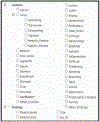The h-ANN Model: Comprehensive Colonoscopy Concept Compilation Using Combined Contextual Embeddings
- PMID: 35373222
- PMCID: PMC8970464
- DOI: 10.5220/0010903300003123
The h-ANN Model: Comprehensive Colonoscopy Concept Compilation Using Combined Contextual Embeddings
Abstract
Colonoscopy is a screening and diagnostic procedure for detection of colorectal carcinomas with specific quality metrics that monitor and improve adenoma detection rates. These quality metrics are stored in disparate documents i.e., colonoscopy, pathology, and radiology reports. The lack of integrated standardized documentation is impeding colorectal cancer research. Clinical concept extraction using Natural Language Processing (NLP) and Machine Learning (ML) techniques is an alternative to manual data abstraction. Contextual word embedding models such as BERT (Bidirectional Encoder Representations from Transformers) and FLAIR have enhanced performance of NLP tasks. Combining multiple clinically-trained embeddings can improve word representations and boost the performance of the clinical NLP systems. The objective of this study is to extract comprehensive clinical concepts from the consolidated colonoscopy documents using concatenated clinical embeddings. We built high-quality annotated corpora for three report types. BERT and FLAIR embeddings were trained on unlabeled colonoscopy related documents. We built a hybrid Artificial Neural Network (h-ANN) to concatenate and fine-tune BERT and FLAIR embeddings. To extract concepts of interest from three report types, 3 models were initialized from the h-ANN and fine-tuned using the annotated corpora. The models achieved best F1-scores of 91.76%, 92.25%, and 88.55% for colonoscopy, pathology, and radiology reports respectively.
Keywords: Clinical Concept Extraction; Colonoscopy; Deep Learning; Natural Language Processing; Word Embeddings.
Figures






References
-
- Abadi M, Agarwal A, Barham P, Brevdo E, Chen Z, Citro C, … Zheng XJA. (2016). TensorFlow: Large-Scale Machine Learning on Heterogeneous Distributed Systems. abs/1603.04467.
-
- Akbik A, Bergmann T, Blythe D, Rasul K, Schweter S, & Vollgraf R (2019). FLAIR: An Easy-to-Use Framework for State-of-the-Art NLP. 10.18653/v1/n19-4010 - DOI
-
- Akbik A, Blythe D, & Vollgraf R (2018). Contextual String Embeddings for Sequence Labeling. Santa Fe, New Mexico, USA: Association for Computational Linguistics.
-
- Alsentzer E, Murphy J, Boag W, Weng W-H, Jindi D, Naumann T, & McDermott M (2019). Publicly Available Clinical BERT Embeddings. Minneapolis, Minnesota, USA: Association for Computational Linguistics.
Grants and funding
LinkOut - more resources
Full Text Sources
